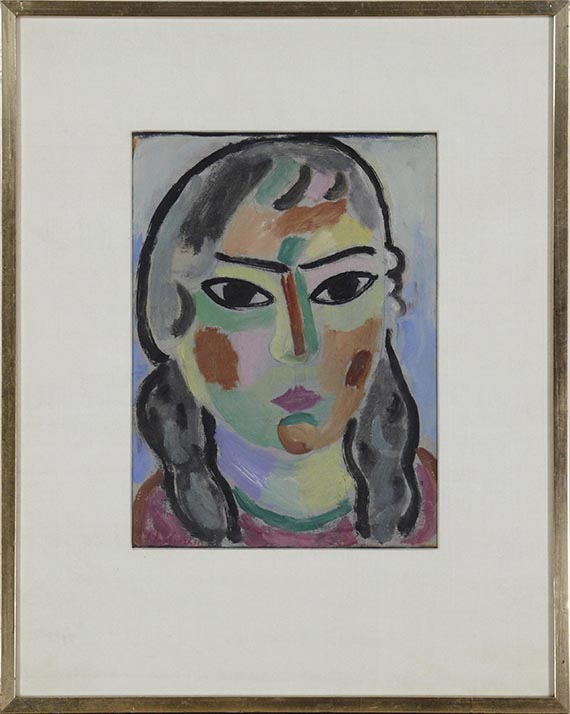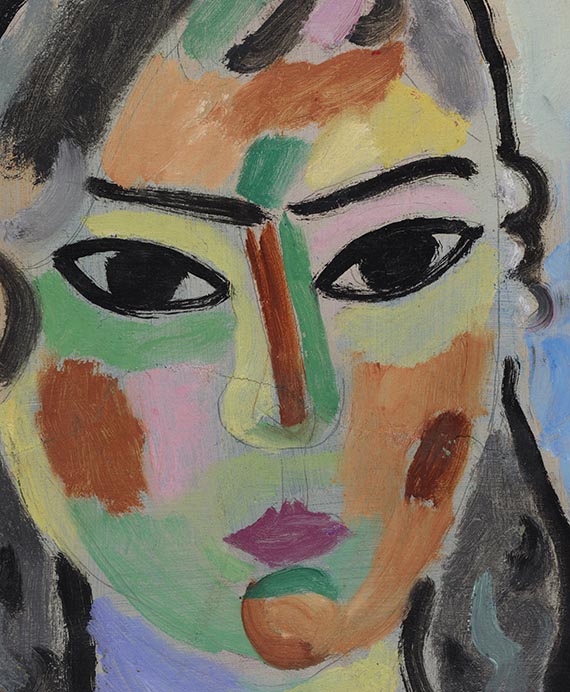27
Alexej von Jawlensky
Mädchen, 1916.
Oil on light board
Estimate:
€ 180,000 / $ 198,000 Sold:
€ 279,400 / $ 307,340 (incl. surcharge)
Mädchen. 1916.
Oil on light board.
Signed in lower left. 35.5 x 26.2 cm (13.9 x 10.3 in).
With a fragmentarily preserved still life study in oil on the reverse, around 1916.
The front is documented on a black-and-white photo in the artist's photo archive. The photo is inscribed: "Mädchen 1916 36/27" (in ink) and "1916.36/27 Mädchen. Kind" (in pencil) by Lisa Kümmel on the backing cardboard. Jawlensky's entry on page 76 in the so-called 'Cahier Noir' with the date "1916 N.4" presumably also refers to this work. [JS].
• Modern aesthetics: Fascinating balance between figuration and abstraction, formal reduction and colors liberated to the max
• Exceptional and seminal: One of the first colorful 'Female Heads', in which Jawlensky took his key motif to a new strength through an airy and liberated style while he was in Swiss exile.
• Documented on a black-and-white photograph inscribed by Lisa Kümmel that is part of the Jawlensky archive.
• Consistent provenance: Sold from the artist's estate to the collection of the painter and art professor Heinrich Dieckmann in the 1940s, it has remained family-owned ever since.
• For the first time offered on the international auction market (source: artprice.com).
PROVENANCE: Artist's estate.
Helene Jawlensky, Wiesbaden (the artist's widow).
Prof. Heinrich Dieckmann, Cologne/Bad Honnef (acquired from the above during World War II, family-owned ever since).
LITERATURE: Maria Jawlensky, Lucia Pieroni-Jawlensky, Angelica Jawlensky, Alexej Jawlensky. Catalogue Raisonné of the Oil Paintings, vol. II (1914-1933), Munich 1992, p. 118, no. 747 (with a black-and-white illu. of both front and back).
"[.] we had to flee to Switzerland with nothing but what we could carry and we got to a small town, St. Prex on Lake Geneva. In our little flat there I had just a small room with one window. I wanted to continue making strong and colorful pictures, but I felt that I just wasn't able to. [..] So I began to look for a new path in art. It was a great accomplishment. I realized I didn't have to paint what I saw, not even what I felt, but only what was going on inside my soul."
Alexej von Jawlensky to P. Willibrord Verkade, June 12, 1938.
Oil on light board.
Signed in lower left. 35.5 x 26.2 cm (13.9 x 10.3 in).
With a fragmentarily preserved still life study in oil on the reverse, around 1916.
The front is documented on a black-and-white photo in the artist's photo archive. The photo is inscribed: "Mädchen 1916 36/27" (in ink) and "1916.36/27 Mädchen. Kind" (in pencil) by Lisa Kümmel on the backing cardboard. Jawlensky's entry on page 76 in the so-called 'Cahier Noir' with the date "1916 N.4" presumably also refers to this work. [JS].
• Modern aesthetics: Fascinating balance between figuration and abstraction, formal reduction and colors liberated to the max
• Exceptional and seminal: One of the first colorful 'Female Heads', in which Jawlensky took his key motif to a new strength through an airy and liberated style while he was in Swiss exile.
• Documented on a black-and-white photograph inscribed by Lisa Kümmel that is part of the Jawlensky archive.
• Consistent provenance: Sold from the artist's estate to the collection of the painter and art professor Heinrich Dieckmann in the 1940s, it has remained family-owned ever since.
• For the first time offered on the international auction market (source: artprice.com).
PROVENANCE: Artist's estate.
Helene Jawlensky, Wiesbaden (the artist's widow).
Prof. Heinrich Dieckmann, Cologne/Bad Honnef (acquired from the above during World War II, family-owned ever since).
LITERATURE: Maria Jawlensky, Lucia Pieroni-Jawlensky, Angelica Jawlensky, Alexej Jawlensky. Catalogue Raisonné of the Oil Paintings, vol. II (1914-1933), Munich 1992, p. 118, no. 747 (with a black-and-white illu. of both front and back).
"[.] we had to flee to Switzerland with nothing but what we could carry and we got to a small town, St. Prex on Lake Geneva. In our little flat there I had just a small room with one window. I wanted to continue making strong and colorful pictures, but I felt that I just wasn't able to. [..] So I began to look for a new path in art. It was a great accomplishment. I realized I didn't have to paint what I saw, not even what I felt, but only what was going on inside my soul."
Alexej von Jawlensky to P. Willibrord Verkade, June 12, 1938.
With the outbreak of the First World War, Jawlensky had to leave the German Reich as he held Russian citizenship in 1914. He left Munich and fled to Switzerland where he and his family would find a new home for the next three years in St. Pex on Lake Geneva. This private disruption also made for a decisive turning point in his art. Jawlensky wrote in his memoirs: "My soul had changed through all the suffering and that required me to find other forms and colors to express what moved me. I began to paint my 'Variations on a Landscape Theme', which I saw from my window. And there were a few trees, a path and the sky. I started painting something to express what nature suggested with colors. Through hard work and with great excitement, I gradually found the right colors and forms to express what my spiritual me demanded." (A. v. Jawlensky, Lebenserinnerungen, quoted from: C. Weiler, Alexej Jawlensky, Hanau 1970 , p. 116). Based on the impression of the landscape in front of his studio’s window, Jawlensky developed a great ability to express his "spiritual self" in form and color. For Jawlensky's art, the natural model was merely the catalyst for a painting that is still representational , but at the same time achieved a maximum degree of abstraction. To this day, the distinctiveness and extraordinary modernity of Jawlensky's painting lies in this fascinating border zone, the oscillation between abstraction and figuration, which the artist primarily explored and developed in numerous landscape variations created in St. Prex The border zone is the individual form of expression with which he is able to give direct expression of his spiritual and emotional feelings - like a composer. When Jawlensky mastered the challenge of intellectual and emotional expression at the end of 1915, he eventually returned to his central and strongest motif, the portrait head, with restored vigor. The present painting "Mädchen (Kind)", recorded in Jawlensky's work notes with the date "1916 N.4", is one of the first of these strong female heads that Jawlensky created in this two-dimensional color scheme characterized by a deep sense of spirituality and a maximum degree of liberation. He put sole focus on the face in frontal view, bordered by a black contour line and the hair, it merely provides a kind of representational frame for a completely free play of form and color. With spontaneous brushstrokes, Jawlensky created a bright, cheerful color sound made up of light green tones, yellow, orange and magenta against a blue modulated background. It is the colors of youth, of a spring-like awakening, which in "Mädchen (Kind)" reflects the mood of Jawlensky's emotional and artistic new beginning in St. Prex. In addition, this step was to be decisive for Jawlensky's de-individualized "Mystical Heads", his "Saviours' Faces" and the "Meditations" that would emerge over the following years. [JS]
27
Alexej von Jawlensky
Mädchen, 1916.
Oil on light board
Estimate:
€ 180,000 / $ 198,000 Sold:
€ 279,400 / $ 307,340 (incl. surcharge)




 Lot 27
Lot 27 

